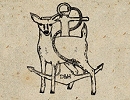Contact Seller
Doe And Hope
Tel07729 213013Please quote Antiques Atlas.


 Victorian Walnut Marquetry Centre Table
Victorian Walnut Marquetry Centre Table
 Set of 3 Stylish Painted Occasional Tables
Set of 3 Stylish Painted Occasional Tables
 Mahogany Pedestal Table c.1830
Mahogany Pedestal Table c.1830
 Antique Victorian Burr Walnut Inlaid Centre Table
Antique Victorian Burr Walnut Inlaid Centre Table
 Chinese Lacquered Coffee Table & Inset Cloisonne
Chinese Lacquered Coffee Table & Inset Cloisonne
 Regency Rosewood Sofa Table
Regency Rosewood Sofa Table
 1880 French walnut silver service tray top table
1880 French walnut silver service tray top table
 Antique Chinese Carved Jardinière Stand, Hardwood
Antique Chinese Carved Jardinière Stand, Hardwood
 Small Marble Top Gueridon Centre Table c.1830
Small Marble Top Gueridon Centre Table c.1830
 Antique Mahogany Console Side Table
Antique Mahogany Console Side Table
 Elegant George III mahogany dish tripod table
Elegant George III mahogany dish tripod table
 Edwardian Aesthetic Style Walnut Side Table
Edwardian Aesthetic Style Walnut Side Table
Non UK callers :
+44 7729 213013
19thC Bleached Oak & Stained Pine Tavern Table


Having a one piece bleached oak oblong top on the original painted pine x-frame legs with two later iron struts, the whole surviving from the middle of nineteenth century England.
The condition is good overall with the top being stable and with some patination whilst the surfaces of the x-frame legs are all original with wear to the stained finish on the trestles and much accretion of old dirt and grime. We have only waxed the top of the piece which shows some areas of wear giving good character with one lighter patch to one end, please see the photographs for a visual reference. The base has been moved at one stage as it was once further towards each end of the top, and it was at this time that the two iron struts may have been added, sometime in the early twentieth century. The table is versatile and could be used as a side or centre table or for dining with it seating six.
The 18th and 19th centuries saw a massive rebuilding of pubs in reaction to changing tastes and the opening of new establishments to meet new demand in industrial and suburban areas. By the end of the 18th century, the saloon was introduced to the pub. It was a kind of a luxury room people could enjoy other entertainment as well as drinking for a higher price or an admission fee. Strictly speaking, inns provided rooms for travellers, taverns provided food and drink, while alehouses simply dished out beery substances. A card room or a billiards room was also popular. By the early 1800s Gin Palaces mushroomed in major cities of Britain, and caused serious health and moral problems in England. These drinking lairs gave birth to in numerous crimes and the deathly epidemic of alcoholism. In response to the Gin Craze, the government passed the Beer Act of 1830, which allowed a new set of premises called the Beer Houses to sell alcohol. Anyone could brew and sell cider or beer in his household after paying a certain rate, but only cider or beer.
A beautiful looking table that has the ability to work wonderfully well in almost any setting.
SellerDoe And Hope
View all stock from
Doe And Hope

 Private dealer, By appointment only
Private dealer, By appointment only
The Onion Barn, Shoe Cottage,
15 High Street, Blunham,
Bedfordshire, MK44 3NL.
MK44 3NL
Tel : 07729 213013
Non UK callers : +44 7729 213013
Get directions to Doe And Hope
The condition is good overall with the top being stable and with some patination whilst the surfaces of the x-frame legs are all original with wear to the stained finish on the trestles and much accretion of old dirt and grime. We have only waxed the top of the piece which shows some areas of wear giving good character with one lighter patch to one end, please see the photographs for a visual reference. The base has been moved at one stage as it was once further towards each end of the top, and it was at this time that the two iron struts may have been added, sometime in the early twentieth century. The table is versatile and could be used as a side or centre table or for dining with it seating six.
The 18th and 19th centuries saw a massive rebuilding of pubs in reaction to changing tastes and the opening of new establishments to meet new demand in industrial and suburban areas. By the end of the 18th century, the saloon was introduced to the pub. It was a kind of a luxury room people could enjoy other entertainment as well as drinking for a higher price or an admission fee. Strictly speaking, inns provided rooms for travellers, taverns provided food and drink, while alehouses simply dished out beery substances. A card room or a billiards room was also popular. By the early 1800s Gin Palaces mushroomed in major cities of Britain, and caused serious health and moral problems in England. These drinking lairs gave birth to in numerous crimes and the deathly epidemic of alcoholism. In response to the Gin Craze, the government passed the Beer Act of 1830, which allowed a new set of premises called the Beer Houses to sell alcohol. Anyone could brew and sell cider or beer in his household after paying a certain rate, but only cider or beer.
A beautiful looking table that has the ability to work wonderfully well in almost any setting.
Price The price has been listed in British Pounds.
Conversion rates as of 16/APR/2025. Euro & Dollar prices will vary and should only be used as a guide.
Always confirm final price with dealer. Phone or visit the website to buy, Free UK shipping.
Category Antique Furniture
Date c.1840
Early Victorian Antiques Material Oak
Origin English
Item code as155a1543
Status Sold
£1250.00 
$1657.13 
€1455.75 

$

€

Conversion rates as of 16/APR/2025. Euro & Dollar prices will vary and should only be used as a guide.
Always confirm final price with dealer. Phone or visit the website to buy, Free UK shipping.
View all stock from
Doe And Hope

 Private dealer, By appointment only
Private dealer, By appointment onlyThe Onion Barn, Shoe Cottage,
15 High Street, Blunham,
Bedfordshire, MK44 3NL.
MK44 3NL
Tel : 07729 213013
Non UK callers : +44 7729 213013
Get directions to Doe And Hope
You may also be interested in
 Victorian Walnut Marquetry Centre Table
Victorian Walnut Marquetry Centre Table
 Set of 3 Stylish Painted Occasional Tables
Set of 3 Stylish Painted Occasional Tables
 Mahogany Pedestal Table c.1830
Mahogany Pedestal Table c.1830
 Antique Victorian Burr Walnut Inlaid Centre Table
Antique Victorian Burr Walnut Inlaid Centre Table
 Chinese Lacquered Coffee Table & Inset Cloisonne
Chinese Lacquered Coffee Table & Inset Cloisonne
 Regency Rosewood Sofa Table
Regency Rosewood Sofa Table
 1880 French walnut silver service tray top table
1880 French walnut silver service tray top table
 Antique Chinese Carved Jardinière Stand, Hardwood
Antique Chinese Carved Jardinière Stand, Hardwood
 Small Marble Top Gueridon Centre Table c.1830
Small Marble Top Gueridon Centre Table c.1830
 Antique Mahogany Console Side Table
Antique Mahogany Console Side Table
 Elegant George III mahogany dish tripod table
Elegant George III mahogany dish tripod table
 Edwardian Aesthetic Style Walnut Side Table
Edwardian Aesthetic Style Walnut Side Table







